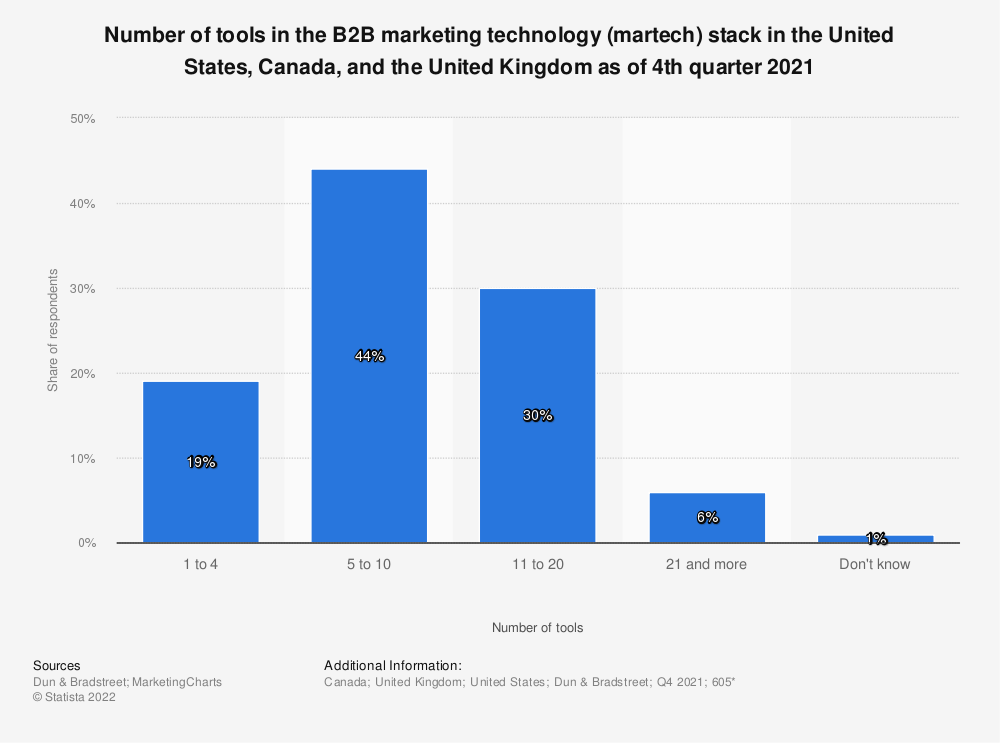How to build a martech stack for improved marketing performance

What is a martech stack, you may well ask? I know I did when I first heard the term. Let’s break down exactly what the term means and how it can increase productivity and improve your marketing.
What is a martech stack?
A martech stack is simply the name given to the collection of marketing technology or software used by a business to support and enhance its marketing efforts. Even if you’re not familiar with the term, you likely already have one.
Forrester found that martech stacks now account for over 20% of the total marketing budget, and 56% of businesses planned to increase their allocated budget to spend on martech. Plus, a huge 82% of marketers said they plan to change their martech stack in 2022. There is a lot of growth in this area because marketing technology is constantly evolving, and martech frees up marketers’ time, and we all know that time is money.
The importance of a martech stack
The importance of a martech stack cannot be overstated in today’s digital age. With the proliferation of marketing channels and the vast amount of customer data available, a martech stack is essential for businesses looking to gain a competitive edge in the market.
By leveraging customer data from various sources, such as CRM systems, social media platforms, and email marketing campaigns, a well-designed martech stack can help automate and streamline marketing processes, improve customer targeting and engagement, and increase marketing ROI. By integrating various marketing tools and technologies, businesses can achieve a holistic view of their marketing efforts and gain valuable insights into customer behavior and preferences.
A martech stack also enables businesses to stay agile and adapt quickly to changing market conditions. As customer expectations and preferences evolve, businesses must be able to respond in real-time to deliver personalized experiences and relevant content. A martech stack can help businesses achieve this by providing the necessary tools and technologies to analyze and act on customer data.
How to build a martech stack
Curating your marketing stack isn’t as intimidating as it sounds. There are no rules and no expectations. It’s as simple as looking at what you need, both as a business and as a team, and going from there. Do you have an SEO specialist on your team, or do you need an all-in-one solution to automate your processes? Once you’ve got an idea of the areas you need support for or simply want to enhance, you need to look at your budget.
38% of marketers cited budget as a barrier to building a martech stack. However, a martech stack optimized for a marketing team’s needs is going to be worth the investment. Once you’ve figured out your priorities and your budget, you can start researching which options will work for you. There is no set number of technologies you should have in your stack.

What does a martech stack look like?
Still unsure of exactly what a martech stack is? Let’s provide some examples. For SEO, we use Semrush for social media scheduling and reporting. Then, for marketing automation, we use Dotdigital (duh), and for CRM, we use Microsoft Dynamics.
That’s just a fraction of our complete martech stack; we simply use technology that works for us, and you should do the same. No business and marketing team will be the same, so it’s highly unlikely any martech stack should be the same.
We have previously had other technologies in our stack too, ones that we’ve since changed to a new offering or simply no longer need, and we’ll likely add new ones in the future too. A martech stack is simply a name for the collective technologies and software your marketing team uses, it’s not a strict parameter, and it can be fluid.
So, how can tech integrations improve your marketing?
Dotdigital is an example of how technology can improve your marketing. Our platform unifies data, which in turn raises insights ready to empower hyper-personalized marketing messages, automated depending on customer behavior. Pretty impressive, right?
The martech industry is vast, with 9,932 martech solutions available. This means you’re highly likely to find what you’re looking for, no matter your industry or need. Dotdigital works with lots of different technologies to strengthen your marketing throughout the customer journey.
Some examples include:
- Customer service platforms like Zendesk to keep records of all interactions in one place
- CRM platforms to support sales team integrations and remove silos
- Ecommerce integrations to improve understanding of customer behavior
- Enhanced personalization through platforms like Movable Ink
If you have any questions about what’s possible, please don’t hesitate to get in touch.
Put into practice
For an example of how one of Dotdigital’s integrations can help, let’s look at Reviews.io. You can set up an automation program that sends customers an email asking them to review your brand on Reviews.io once they’ve completed a purchase.
You can also have an automation set up to send a follow-up email based on the review they leave. Three stars or under? Nurture campaign. Four or five stars? Thanks for your review. Have you checked out this similar product? You get the idea.
The journey is seamless back and forth. You’re prompting customers from your communication platform, letting them provide a review on the review platform, and then following up on your communications platform. This is a great example of two technologies that offer different services working together to bridge the gap—exactly what a good martech stack is all about.
But wait, there’s more. You can also use the social proof editor within Reviews.io to create a graphic and have that automatically appear in your Dotdigital image library. That extra hit of social proof ready and waiting in your image library to add to your welcome campaigns can make all the difference to your conversion rates.
And the best part? No one on the team had to spend time looking for good reviews, creating an image, and manually uploading it to Dotdigital. The result is stronger marketing campaigns, as well as more time on your hands.
Working together
As soon as you’ve identified the technology you need, make sure it works together. As we’ve just explored, your martech stack is there to support you and make your day-to-day run smoother. You don’t want to be bogged down in manual tasks to share data from one platform to the next.
When your technology works together, it’s going to be more effective overall. Knowledge is power right? If system B knows what a customer has done on system A, it can better market to them based on this and let systems C, D, E, and F know too.
Of course, it won’t be this linear in reality, as your customers’ journeys aren’t linear. Your stack will be a collection of tech platforms that work in different areas as and when they’re required, in no particular order.
The point remains that your tech platforms communicating with each other is key. Data-driven marketing is imperative for success. The technology is there to strengthen your customers’ journey, so being aware of what happens throughout that is crucial. Think of your stack more like a web, with each piece of technology or software able to connect with each other.
You need to ensure that multiple systems are integrated to transform a wealth of customer data into reliable, contextual, and timely insights and make that information easily accessible to other platforms that can take action on those insights.
Choosing technology partners based on their integration capabilities with your existing technology is imperative to building a marketing stack you can rely on. This will in turn improve your customer journey, and as we all know, a positive customer experience leads to higher rates of customer loyalty.
How can Dotdigital improve your martech stack?
With 46% of marketers citing the complexity of integrating the technologies as their top barrier to creating a martech stack, we understand it can feel daunting. We know that your time is valuable, so we offer both out-of-the-box integrations so you can get started straight away and a bespoke solution if your stack requires a bit more tailoring. (Our developers always love a new challenge).
Our marketing automation software is the best in the biz thanks to data unification, cross-channel functionality, and leading marketing automation. And while our platform does a lot, it can’t do everything.
Dotdigital is designed to work with the best of the best in other areas too, such as ecommerce, social media, review platforms, and so on, so that you can create a truly joined-up stack. Our integration hub is a great place to start exploring, as it explains how you can integrate Dotdigital with other marketing software.
Embrace technology
Marketing is a broad discipline, and there’s a lot to keep track of. As consumers have largely moved online, the tactics and tools used to engage with customers have become more and more technology-based.
Back in the day, print advertising and direct mail were huge channels, these days, social media ads and email marketing are more common. Even billboards, which used to be printed out and pasted on by someone climbing up a ladder with a bucket and brush, are now digital screens that can be updated at the touch of a button.
The point is, technology is undeniably a huge part of marketing, and it’s only going to continue to grow. It can be hard to know where to start, what’s going to be worth your investment, and how to make it all work together.
However, if you start by looking at what you need, researching what’s available, and curating a stack tailored to your business, it’s going to benefit both your marketing output itself and your team’s productivity.



